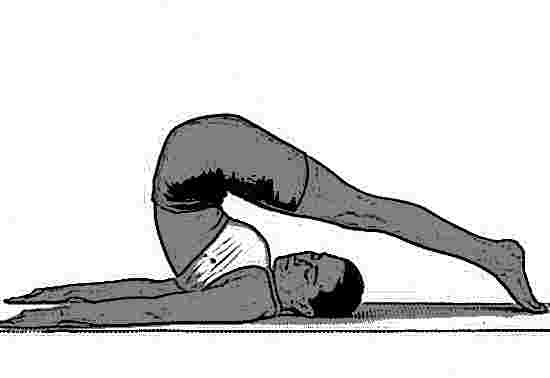Halasana is known as plough posture, since your body will take the shape of a plough when you practise this. The Sanskrit word for plough is hala.
Procedure for Halasana
- You should spread a blanket on the floor and lie flat on your back. The hands should be kept at your sides on the floor with your palms touching the ground. Your legs should remain joined.
- You should now lift your legs upward very slowly. The legs should remain straight without any bending and the hands should be firmly on the floor. The trunk also should not bend. You should raise your legs until they are at an obtuse angle.
- From that position, you should proceed further to fold the legs over your body and lower your legs until they are away from your head and the toes touch the ground. The knees should remain straight and very close together. The back should be straight with only the neck and the head touching the floor. The thighs and legs should be in a straight line.
- You should press the chin against your chest and slowly breathe through your nose. The breathing should not be through the mouth.
- You can hold this position as long as possible.
- You should slowly raise your legs and return to your original posture of lying on your back on the floor. There should be no jerk anywhere when you take your legs behind your head or when you bring them back to the original position.
Benefits of Halasana
The focus of Halasana is on the thyroid. This asana calms your brain, stimulates your thyroid gland and abdominal organs. Halasana stretches your spine and shoulders. It helps in relieving symptoms of menopause. Halasana reduces fatigue and stress significantly. Halasana is therapeutically helpful for insomnia, headache, backache, infertility, and sinusitis. It tones up and nourishes the muscles of your thighs, muscles of your abdomen, and the rectal muscles. Halasana also cures chronic or habitual constipation, congestion, gulma, corpulence or obesity and enlargement of the spleen and liver. If you practice Halasana, you will feel very active and never be lazy.
Halasana tones the muscles in your back, the spinal nerves, the vertebral bones and all sympathetic nervous systems running along your vertebral column on both sides. When you do this asana, a higher quantity of blood flows through the spinal cord, muscles of the back, spinal roots of the nerves, sympathetic nerves and sympathetic ganglia, so that they get thorough nourishment. The vertebral column becomes highly elastic and soft. Further, Halasana prevents early ossification of your vertebral bones or faster degeneration of these bones. Early ossification will make you look older and the bones will become brittle and hard in this degenerative process. Halasana is a good cure for different types of myalgia or muscular rheumatism, sprain, neuralgia and lumbago also. Doing this asana under the guidance of an experienced yoga master is advisable.
Precautions and Contraindications
People suffering from diarrhoea, neck injuries, high blood pressure, and asthma should not practise this asana. Women should not perform Halasana during the menstruation period. Pregnant women can continue this asana if they have been practising it before becoming pregnant but it is not advisable. Since Halasana is an advanced asana, it is better if you become perfect in Sarvangasana before proceeding from that to Halasana, since it is an amplification of Sarvangasana.
Variations
Instead of keeping your hands in the original position, you can move them towards your legs and catch hold of the toes. You should do this also without any jerk.
One major variation of Halasana is Parsva Halasana or flank plough posture. In the Halasana posture, you should walk your feet towards your left side as far as possible, while exhaling. When you do this, one of your hips may tend to sink towards the ground. Hence, you should try and keep your pelvis in a neutral position, with the hips remaining parallel to the ground. You can remain in that position between 30 seconds and 1 minute. You can return back to Halasana position inhaling. You can now repeat this towards the right side and return back. From that position, you can release yourself from Halasana through step 6.

